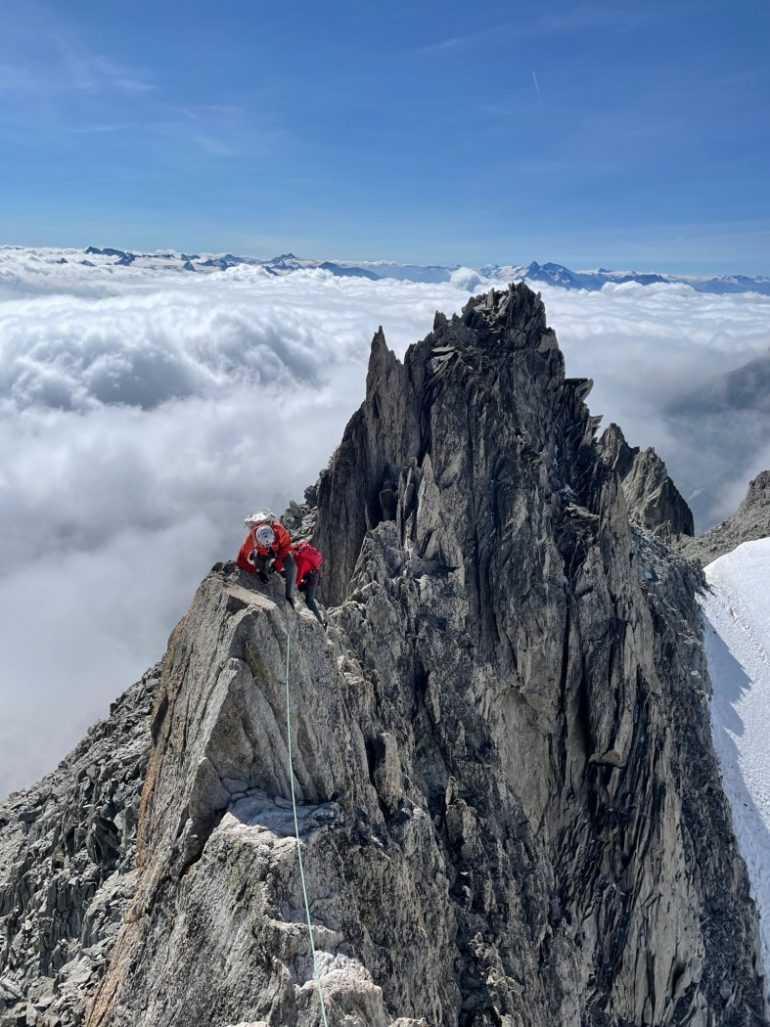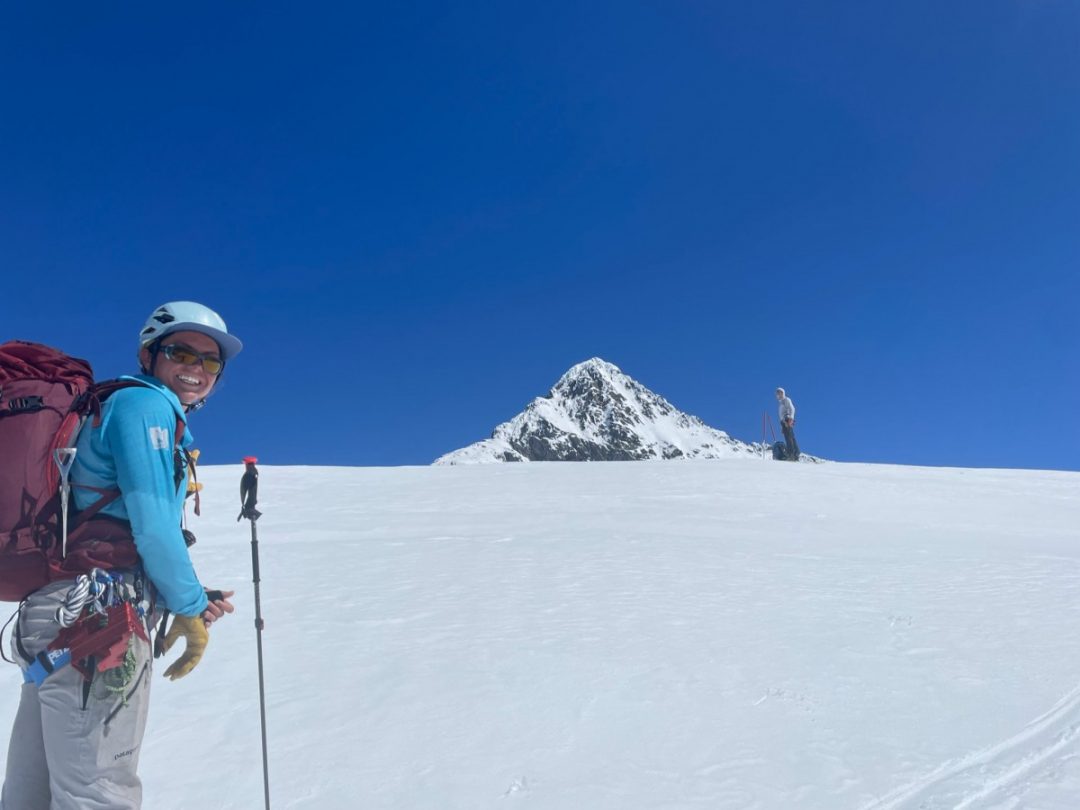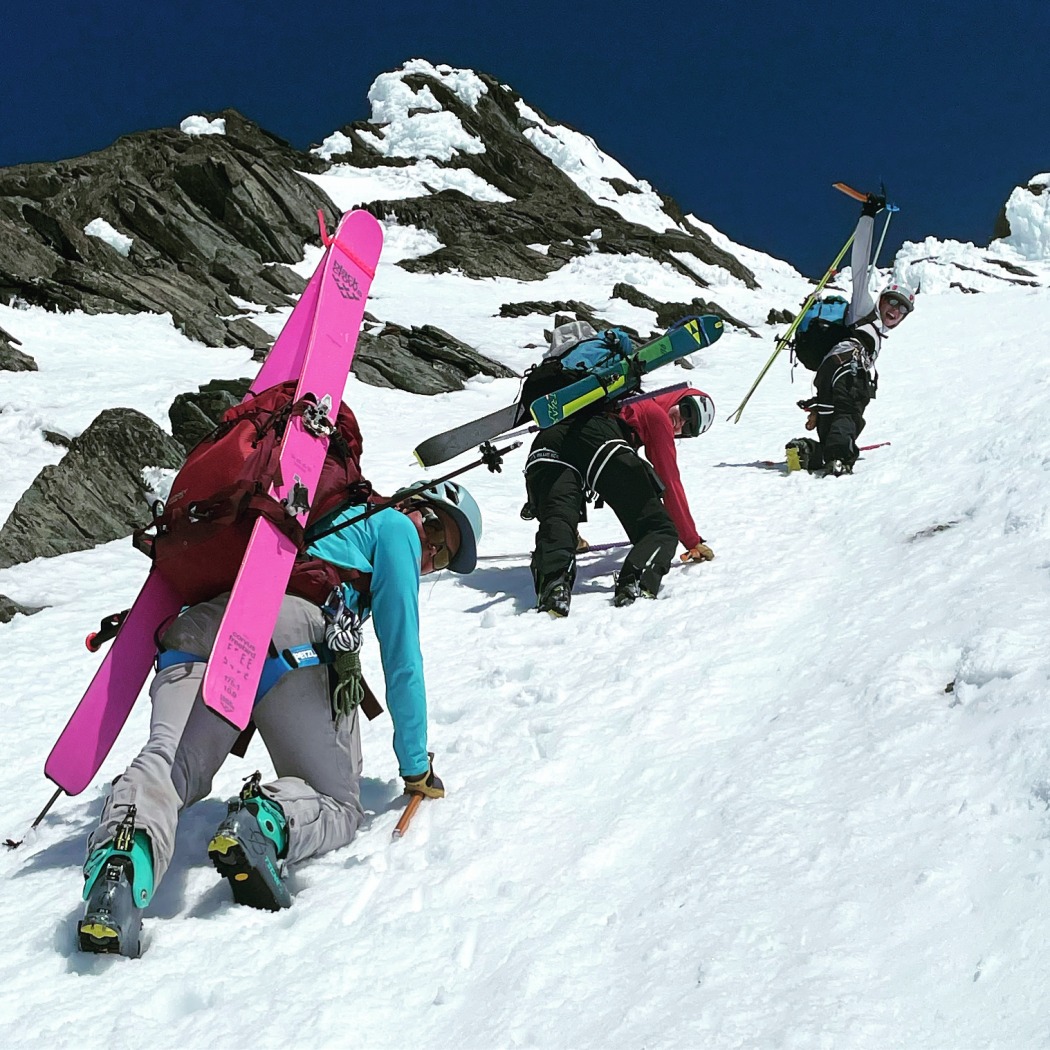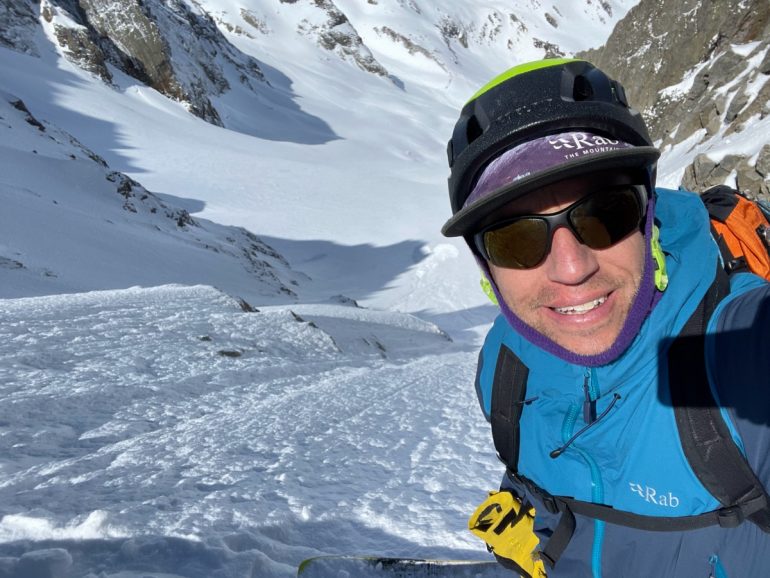
Two climbers traverse the iconic Aiguille d’Entreves, along the border of Italy and France, on the Mont Blanc Massif. Photo: Rob Coppolillo.
Chamonix gets hyped a lot — host of the first Winter Olympics in 1924, site of the oldest mountain guide office (1821) in the world, and of course, “Cham” claims a circus of some of the best climbers and skiers on the planet as its “local” crew. No wonder this town of 8000 in the French Alps routinely pops up in the mags and on film.
I had visited Chamonix a dozen-or-so times before moving there in 2019. In 1996, when “The Cantina” was still serving Mexican(ish) food and before the tunnel beneath Mont Blanc burned, I shared an evening with family there. On leaving, I promised to come back. Over the ensuing years, I would visit to work and see friends. I recall hearing someone refer to the little valley as “The Madison Square Garden of Guiding.”
Huh?
To the Garden …
My family and I relocated to Chamonix in August of 2019, as I was finishing The Ski Guide Manual. Writing consumed my autumn, and I spent most of January in Canada, returning to Cham in February 2020. A few weeks of work and … well, you know the rest: lockdowns, viruses, general global upset.
After living there for just over two years, I’m still a huge fan and realistic about its shortcomings, too. Madison Square Garden might go a little far, but it’s pretty great on balance.
Access to world-class rock and alpine terrain, five different ski areas, and a motivated community make it pretty hard to beat. It’s one of the few places in the world where you can walk the kids to school in your ski boots (or ride!), then book over to the tram and be on a glacier a half-hour later, stepping into skis. A couple of laps, and you can pick up the kids, have dinner with the family, and sleep in your own bed. And the wages are way better than the States, too — I miss it!
Another bonus: the region takes care of its guides — a season pass gets you on all five ski hills (for the whole year, not just the winter), as well as the tram up the Aiguille du Midi, for just 230 euros. Travel with your guide card, and you can get a ticket just about anywhere in the Alps for 15 euros. And touring out the gates? Just about anywhere, any time. Ride the lifts, save your legs for skiing!
I sincerely enjoyed watching alpinists, skiers, and guides from all over the world work. Occasionally you’d see something spooky, but for the most part, working alongside an international community of guides exposes you to new techniques and mindsets. Watching Brits short-rope, the Swiss lead guests on a knife-edge ridge, and the Euro-based Americans ski-guide pushed me to reevaluate my skill in the mountains. I hope I picked up a few of their tricks and improved.
All this, and you’re 12-kilometers from Italy, where the fruit arrives daily from the south and everything costs 30-percent less. The promised land!
And hey, taxes were lower for us, the benefits way better, too … yeah, it was good.
But …
Despite the hype, Chamonix, like any legendary mountain town, has its blind spots. You’re probably a skier/climber, like me, so imagine living in a place with so many mountain professionals working daily … and you can’t get the overnight weather history from the ski hills, nor the Aiguille du Midi. Moreover, there’s no professional data-sharing platform for the hundreds of mountain guides living between Aosta, Chamonix, and Zermatt. After living and working in North America, especially Canada, it feels downright crazy to head up the tram, 2800m, and not know what the wind did overnight. No clue what the Italians are seeing on their side of the mountain.
Guides broke into camps, often sharing weather and snowpack observations amongst themselves, which could be helpful if you knew whom to contact. By the end of our time there, I had met a nice mix of British, Eastern European, Italian, Spanish, and a few French guides, so I could ask for beta from them. It was fractured, though, between texting, WhatsApp groups, and the usual panicked phone calls (mostly from me!) about where to go if we woke up to unexpected weather, for example.
It was great having a posse of Americans who’d been there for years, but you can only text them so much before you become a pest. Most of ‘em have families, too, so there’s sick kids, school runs, and the like to contend with. A resource like the Canadian InfoEx — the most comprehensive observation tool for ski professionals — would be so cool in the western Alps, but the idea just hasn’t gained traction.
We found the schools to be less-than-stellar, too. Kids with ADHD and autism weren’t afforded the latest in teaching methods and research. Rather, more rules, and “be more strict,” seemed to be the mindset. Our kids are typical learners, but watching some teachers yell and humiliate their classmates, bummed them out. By year’s end, they were pretty discouraged, and when schools in France started talking about closing again in 2021, our boys had run out of gas for it.

Erika Birkeland and Henry Coppolillo on their way to skiing off the summit of Mount Shuksan. Photo: Rob Coppolillo.
Finally, after 18 months of covid, on-off lockdowns, we cracked and moved back to the States, to an island just west of Seattle. While it’s not my first choice on the planet, our little dudes, and my wife, are definitely happier here, so far.
And the Cascades. The Cascades! My first trips here, just a decade ago, made me a believer. I remember saying to a climbing partner, “These mountains are so underrated. They’re awesome!”
Growing up in Colorado, you hear about “14’ers” and “champagne powder,” and the legendary Eldorado Canyon for rock climbing. Start traveling, though, and you realize the marketing folks in Colorado tend to exaggerate a bit.
“Puny” Mount Shuksan (“only” 9131ft) has wonderful, glaciated ski-mountaineering and superb trade routes for alpine guiding, despite its diminutive size. The north face of Mount Buckner (9114ft) offers a proud ski line, as cool as anything in Colorado and on par with a north face in the Alps. And you make those first, 50-degree turns, lower than the parking lot at Bear Lake, in Rocky Mountain National Park. It also snows a ton up here, especially during a La Nina year like this one — storms accumulate in feet, not inches.
Add to that true wilderness like the Pickets, Yosemite-quality rock at Index, and of course, the mighty Mount Rainier, with more than two-dozen independent ski lines on a glaciated, 4000m peak. Oh yeah!
Of course, the Cascades and Pacific “NorthWet” suffers, too. North Bend, just on the west side (the wet side!) of Snoqualmie Pass, receives 75 inches of rain annually. The access can be tricky too — four large guide services hold exclusive permits on Mount Rainier. You’ll see vastly more uncertified, rather than certified, guides working on a Rainier.

Racing the sun! The final minutes of frozen snow, just below the summit of Mount Shuksan. Photo: Rob Coppolillo.
If you take account, though, the mountain biking, trail running, skiing, climbing, and the world-class food-art-culture scene in Seattle, and the PNW’s proximity to Canada, man … another tough-to-beat location!
Lucky … and Where’s My Stuff?!
Ah, any way you slice it, Boulder, Cham, or Seattle, they’re all great places. I’m lucky to have landed here, close to my wife’s family; with a welcoming, friendly guide community established, and work to be had.
Our only glitches now — our container of stuff from France has gone missing and … does anybody have a million bucks we can borrow for a house?

Henry Coppolillo belaying the final meters to Shuksan’s summit. A bountiful winter snowpack meant turns right off the top. Photo: Rob Coppolillo.
We shipped one-third of a container on August 26, from Chamonix. Epic packing, a lucky sale to good friends furnishing a house, and we pared out stuff down as much as we could. That said, our container arrive at the Port of Los Angeles sometime in early October, sat for a couple of weeks, then cleared customs towards the end of the month … and during November we haven’t heard a peep.
Skis, bikes, sweaters, and knick-knacks … I need my stuff!
The shipping company promises it will arrive, someday, and in the meantime, if anybody has a million bucks they want to drop on a house in Seattle, let us know.
Rob Coppolillo is the author of The Ski Guide Manual and The Mountain Guide Manual and an internationally licensed mountain guide. He’s now based in Seattle, Washington and owns Vetta Mountain Guides.
Rob Coppolillo is a mountain guide and writer, based on Vashon Island, in Puget Sound. He’s the author of The Ski Guide Manual.

